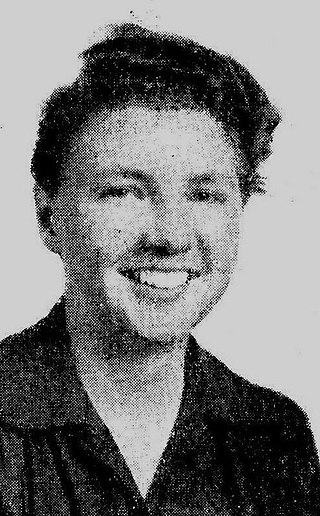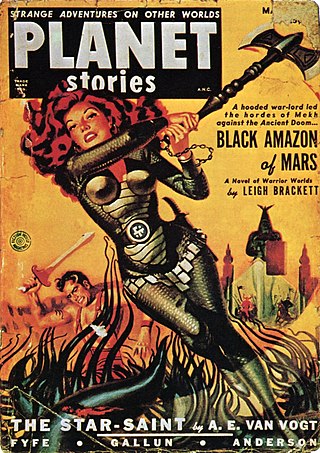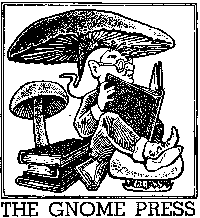Related Research Articles

Cyril M. Kornbluth was an American science fiction author and a member of the Futurians. He used a variety of pen-names, including Cecil Corwin, S. D. Gottesman, Edward J. Bellin, Kenneth Falconer, Walter C. Davies, Simon Eisner, Jordan Park, Arthur Cooke, Paul Dennis Lavond, and Scott Mariner.

Mars, the fourth planet from the Sun, has appeared as a setting in works of fiction since at least the mid-1600s. Trends in the planet's portrayal have largely been influenced by advances in planetary science. It became the most popular celestial object in fiction in the late 1800s, when it became clear that there was no life on the Moon. The predominant genre depicting Mars at the time was utopian fiction. Around the same time, the mistaken belief that there are canals on Mars emerged and made its way into fiction, popularized by Percival Lowell's speculations of an ancient civilization having constructed them. The War of the Worlds, H. G. Wells's novel about an alien invasion of Earth by sinister Martians, was published in 1897 and went on to have a major influence on the science fiction genre.

Leigh Douglass Brackett was an American science fiction writer known as "the Queen of Space Opera." She wrote the screenplays for The Big Sleep (1946), Rio Bravo (1959), and The Long Goodbye (1973). She worked on an early draft of The Empire Strikes Back (1980), elements of which remained in the film; she died before it went into production. In 1956, her book The Long Tomorrow made her the first woman ever shortlisted for the Hugo Award for Best Novel, and, along with C. L. Moore, one of the first two women ever nominated for a Hugo Award.

Alien invasion or space invasion is a common feature in science fiction stories and films, in which extraterrestrial lifeforms invade Earth to exterminate and supplant human life, enslave it, harvest people for food, steal the planet's resources, or destroy the planet altogether. It can be considered as a science-fiction subgenre of the invasion literature, expanded by H. G. Wells's seminal alien invasion novel The War of the Worlds, and is a type of 'first contact' science fiction.

Stanley Grauman Weinbaum was an American science fiction writer. His first story, "A Martian Odyssey", was published to great acclaim in July 1934; the alien Tweel was arguably the first character to satisfy John W. Campbell's challenge: "Write me a creature who thinks as well as a man, or better than a man, but not like a man." Weinbaum wrote more short stories and a few novels, but died from lung cancer less than a year and a half later.

Planet Stories was an American pulp science fiction magazine, published by Fiction House between 1939 and 1955. It featured interplanetary adventures, both in space and on some other planets, and was initially focused on a young readership. Malcolm Reiss was editor or editor-in-chief for all of its 71 issues. Planet Stories was launched at the same time as Planet Comics, the success of which probably helped to fund the early issues of Planet Stories. Planet Stories did not pay well enough to regularly attract the leading science fiction writers of the day, but occasionally obtained work from well-known authors, including Isaac Asimov and Clifford D. Simak. In 1952 Planet Stories published Philip K. Dick's first sale, and printed four more of his stories over the next three years.

David Starr, Space Ranger is the first novel in the Lucky Starr series, six juvenile science fiction novels by Isaac Asimov that originally appeared under the pseudonym Paul French. The novel was written between 10 June and 29 July 1951 and first published by Doubleday & Company in January 1952. Since 1971, reprints have included an introduction by Asimov explaining that advancing knowledge of conditions on Mars have rendered some of the novel's descriptions of that world inaccurate. The novel was originally intended to serve as the basis for a television series, a science-fictionalized version of The Lone Ranger, but the series was never made, in part because another series called Rocky Jones, Space Ranger was already in the planning stages.
The Golden Age of Science Fiction, often identified in the United States as the years 1938–1946, was a period in which a number of foundational works of science fiction literature appeared. In the history of science fiction, the Golden Age follows the "pulp era" of the 1920s and 1930s, and precedes New Wave science fiction of the 1960s and 1970s. The 1950s are, in this scheme, a transitional period. Robert Silverberg, who came of age then, saw the 1950s as the true Golden Age.

Gnome Press was an American small-press publishing company primarily known for publishing many science fiction classics. Gnome was one of the most eminent of the fan publishers of SF, producing 86 titles in its lifespan — many considered classic works of SF and Fantasy today. Gnome was important in the transitional period between Genre SF as a magazine phenomenon and its arrival in mass-market book publishing, but proved too underfunded to make the leap from fan-based publishing to the professional level. The company existed for just over a decade, ultimately failing due to inability to compete with major publishers who also started to publish science fiction. In its heyday, Gnome published many of the major SF authors, and in some cases, as with Robert E. Howard's Conan series and Isaac Asimov's Foundation series, was responsible for the manner in which their stories were collected into book form.

Many works of fiction have featured UFOs. In most cases, as the fictional story progresses, the Earth is being invaded by hostile alien forces from outer space, usually from Mars, as depicted in early science fiction, or the people are being destroyed by alien forces, as depicted in the film Independence Day. Some fictional UFO encounters may be based on real UFO reports, such as Night Skies. Night Skies is based on the 1997 Phoenix UFO Incident.

Platinum Pohl is a collection of thirty science fiction stories by Frederik Pohl first published in December 2005 by Tor Books (ISBN 0-312-87527-4). It includes a volume introduction and story introductions by the editor, James Frenkel, plus an afterword by Pohl.

"A Martian Odyssey" is a science fiction short story by American writer Stanley G. Weinbaum originally published in the July 1934 issue of Wonder Stories. It was Weinbaum's second published story, and remains his best known. It was followed four months later by a sequel, "Valley of Dreams". These are the only stories by Weinbaum set on Mars.
Tweel is a fictional extraterrestrial from the planet Mars, featured in two short stories by Stanley G. Weinbaum. The alien was featured in A Martian Odyssey, first published in 1934, and Valley of Dreams four months later. Weinbaum died of lung cancer soon after, and a third installment in the series never saw fruition. Tweel remains one of the most recognised aliens in early science fiction, and is said to be an inspiration for aliens in the works of Isaac Asimov and Arthur C. Clarke.

In the Courts of the Crimson Kings is a 2008 alternate history science fiction novel by American writer S. M. Stirling.

Barsoom is a fictional representation of the planet Mars created by American pulp fiction author Edgar Rice Burroughs. The first Barsoom tale was serialized as Under the Moons of Mars in pulp magazine The All-Story from February to July 1912 and published compiled as a novel as A Princess of Mars in 1917. It features John Carter, a late-19th-century American Confederate veteran who is mysteriously transported from Earth to the dying world of Mars where he meets and romances the beautiful Martian princess Dejah Thoris. Ten sequels followed over the next three decades, further extending his vision of Barsoom and adding other characters.
This is an incomplete list of works by American space opera and science fiction author Frederik Pohl, including co-authored works.
The year 1950 was marked, in science fiction, by the following events.
The year 1952 was marked, in science fiction, by the following events.
The year 1954 was marked, in science fiction, by the following events.
References
- ↑ "Godzilla & Godzilla Raids Again". Godzilla & Godzilla Raids Again. University of Minnesota Press. Retrieved 18 September 2023.
- ↑ "The Beast with a Million Eyes (1955)". IMDB. Retrieved 2009-03-30.
- ↑ Palmer, Randy (1997). Paul Blaisdell, monster maker: a biography of the B movie makeup and special effects artist. McFarland. pp. 30–32. ISBN 0-7864-0270-9.
- ↑ Weaver, Tom (2003). Double feature creature attack: a monster merger of two more volumes of classic interviews. McFarland. p. 153. ISBN 0-7864-1366-2.
- ↑ Erickson, Hal (2012). "King Dinosaur (1955)". Movies & TV Dept. The New York Times . Archived from the original on 2012-10-21. Retrieved 2009-06-10.
- ↑ Kinnard, Roy (1988). Beasts and behemoths: prehistoric creatures in the movies. Rowman & Littlefield. pp. 74–76. ISBN 0-8108-2062-5.
- ↑ "1955 Hugo Awards". World Science Fiction Society. 2007-07-26. Archived from the original on 2011-05-07. Retrieved 2010-04-19.